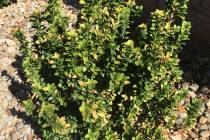As soon as you plant your crepe myrtle, it will start straightening as it grows. The light will come at it from all different directions unlike in the nursery. When you plant it, plant it as straight as possible and let the plant figure it out with new growth.
- Home
- >> Local
- >> Local Columns
Bob Morris
Bob Morris is a horticulture expert living in Las Vegas and professor emeritus for the University of Nevada. Visit his blog at xtremehorticulture.blogspot.com. Send questions to Extremehort@aol.com.
A volunteer opportunity to plant shrubs and flowers around the Nevada Garden Clubs Center will be held March 4 starting at 7 a.m.
Cuttings from citrus trees should be cut slanted at the bottom and straight across at the top end. Cutting them slanted at the bottom end helps to not confuse the top from the bottom.
Rose are fertilized sometime toward the end of January when growth starts. They will need a second application of fertilizer just before it gets hot — about eight to 12 weeks later.
Desert spoon comes from the cooler Chihuahuan Desert’s higher elevations. Desert spoon doesn’t like heat over 110 degrees very much.
Pomegranate handles heat from a hot wall better than either apricot or peach. Anything you plant there should be heat tolerant.
If you are going to apply an iron fertilizer it should be in a chelated form. The best all-around chelate to use is a chelated iron fertilizer called EDDHA.
You’ve got to kill Bermuda grass when it’s alive, which starts growing in late spring, and seed the bare areas after all the grass in that area dies.
Q: Is it possible to grow sour or bitter orange in Las Vegas? It’s becoming almost impossible to find at the local markets, and we use it in so many recipes. I was curious if that was something that might grow here. When should I plant it?
Our desert is a great place to grow strawberry guava. Pick a non-windy place in your landscape for planting. This protected location should get at least six hours of direct sunlight.
Chilling injury is due to cooler or cold weather (above freezing) temperatures to tropical plants growing outside of — or close to — the fringes of their normal range.
After a tree is damaged during a windstorm, healing can take two to three years if the tree is kept in good health. To do that, clean up the wound and apply management practices that encourage it to heal.
A deep watering once a week in the winter should be all that is necessary for sago palms in most soils and locations except the hottest.
Yellowing of bottle brush leaves oftentimes occurs when the soil is low in nutrients and organic matter content. Fix yellowing leaves by applying a landscape fertilizer every year in the spring and combine it with an annual application of chelated iron.
Big trees use quite a bit of water. The cost of watering these trees must be balanced with the need for cooling.

















